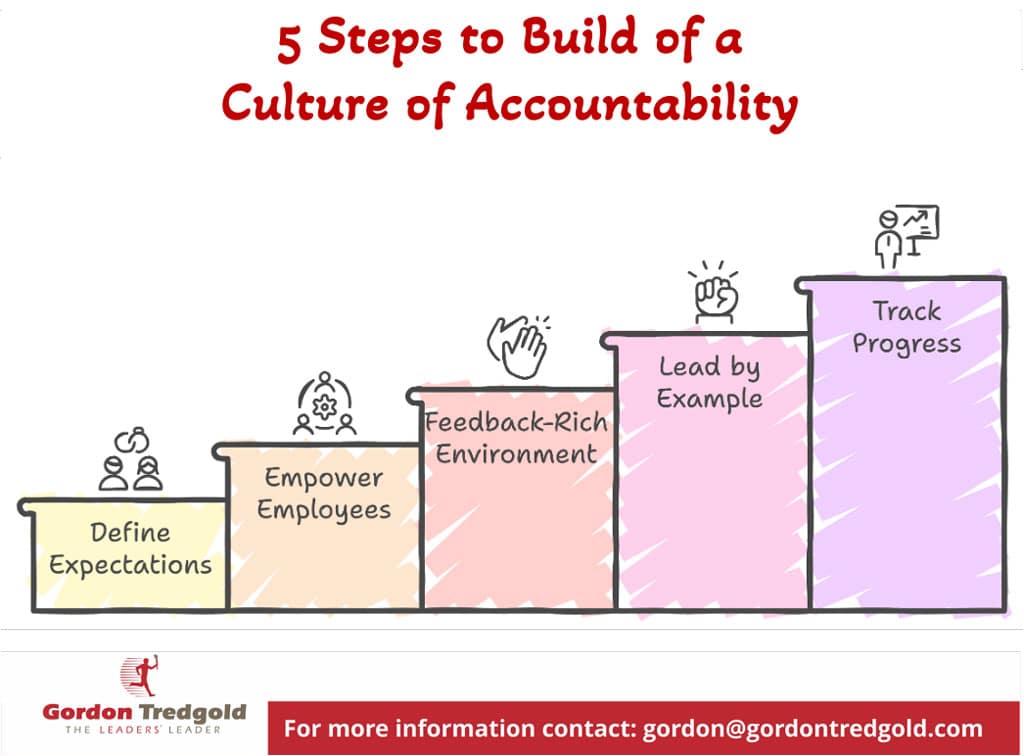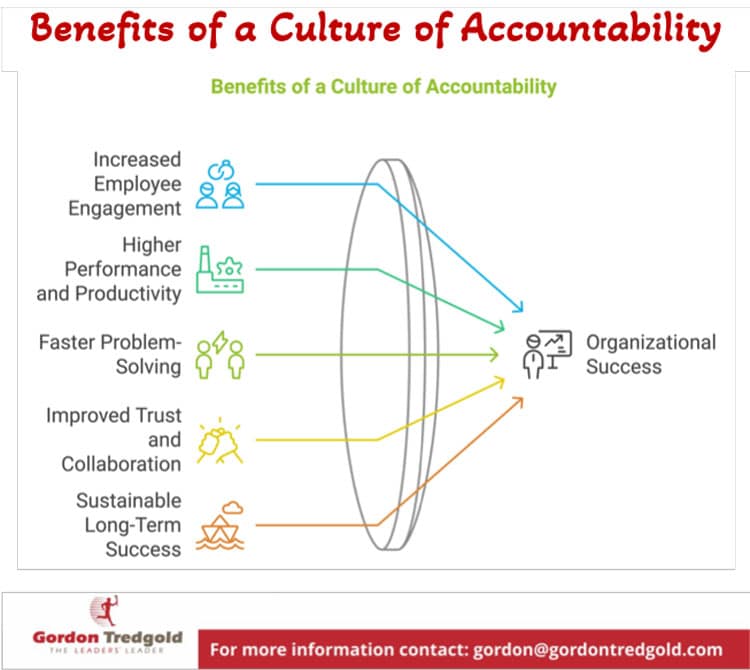In today’s fast-paced business environment, accountability is a key driver of success. Yet, many CEOs struggle to cultivate a culture where accountability is embedded into the DNA of their organization. When accountability is absent, inefficiencies, finger-pointing, and missed goals become all too common. On the other hand, when employees are empowered to take ownership of their responsibilities and outcomes, the entire company thrives.
Here are five essential steps every CEO should take to build a culture of accountability that drives long-term success.

Step 1: Define Clear Expectations and Goals
Accountability begins with clarity. If people are unsure of what’s expected of them, how can they be held accountable? This step requires defining clear goals, roles, and responsibilities throughout the organization. Every individual needs to understand not only what their job entails but how their efforts contribute to the larger organizational goals.
To do this effectively:
- Set SMART goals (Specific, Measurable, Achievable, Relevant, and Time-bound) for both teams and individuals.
- Use your leadership to align the team’s goals with the overall mission and vision of the company.
- Ensure expectations are communicated clearly and regularly, leaving no room for ambiguity.
By providing clarity from the top, you’re setting the foundation for accountability. Employees are much more likely to take ownership when they know exactly what’s expected of them and how their performance will be measured.
Step 2: Empower Employees to Take Ownership
Once the goals and expectations are clear, it’s important to empower your employees to take ownership of their work. Micromanagement stifles accountability and makes employees feel as though they can’t be trusted. Instead, encourage autonomy by giving employees the freedom to make decisions within their role.
Empowered employees are more likely to:
- Feel invested in their work, knowing they are trusted to deliver results.
- Develop innovative solutions and take calculated risks, because they are confident in their ability to drive change.
- Hold themselves accountable for the outcomes of their decisions, whether positive or negative.
To build this culture of ownership, encourage employees to seek solutions before problems escalate, take initiative, and be proactive. Let them know that you trust them to make decisions, and hold them accountable for both successes and setbacks. This empowerment is the key to fostering a sense of ownership across all levels of the organization.
Step 3: Build a Feedback-Rich Environment
For accountability to flourish, there must be regular and transparent feedback loops within the organization. Employees need to know how they are performing and where they can improve. As a CEO, your responsibility is to build a feedback-rich culture where feedback flows both up and down the organization.
Here’s how you can achieve that:
- Regular check-ins: Schedule frequent, short check-ins with teams and individuals to provide feedback and discuss progress.
- Peer feedback: Encourage peer-to-peer feedback to create a holistic understanding of performance. When employees hold each other accountable, they become more self-aware of their own performance.
- Recognition and correction: Celebrate successes and quickly address underperformance. Feedback should always be balanced—acknowledging what is going well while being honest about what needs to improve.
Timely feedback is critical. Waiting until an annual review to discuss issues does little to reinforce accountability. Instead, focus on continuous improvement by providing constructive feedback regularly.
Step 4: Lead by Example
Leadership sets the tone for the rest of the organization. If a CEO and senior leadership team demonstrate accountability in their actions, decisions, and behavior, employees will follow suit. Accountability starts at the top.
Here’s how you can lead by example:
- Be transparent about your decisions: If you make a mistake, own it publicly and discuss how you plan to rectify it. Transparency fosters trust and encourages others to follow your lead.
- Hold yourself accountable to the same standards: Whatever expectations you have for your employees should apply to you as well. Show that you’re committed to your own growth and performance.
- Deliver on your promises: Consistently follow through on commitments, and ensure your leadership team does the same.
When employees see that leadership is committed to the same level of accountability, it reinforces the cultural norm. Your behavior sets the standard for the rest of the company.
Step 5: Track Progress and Celebrate Wins
The final step in building a culture of accountability is to ensure that progress is tracked and recognized. Measuring performance is crucial for holding people accountable, but so is celebrating the wins—big and small.
Here’s how you can implement this step:
- Use data-driven tools: Implement tracking systems that provide clear, measurable data on key performance indicators (KPIs) for both individuals and teams. This can include using dashboards, reports, and performance reviews.
- Regular progress reviews: Check-in on progress at key milestones. When progress is visible, it not only reinforces accountability but also serves as motivation for teams.
- Celebrate the wins: Acknowledging success is just as important as addressing areas of improvement. Publicly recognize teams or individuals who have met or exceeded expectations. This helps to reinforce positive behavior and keeps people engaged in achieving further success.
By tracking progress and celebrating successes, you reinforce accountability in a positive and motivational way. When employees see the impact of their efforts, they’re more likely to take ownership and strive for even greater achievements.
Benefits of a Culture of Accountability
Now that we’ve gone through the five steps to build a culture of accountability, let’s look at some of the tangible benefits this can bring to your organization.

1. Increased Employee Engagement
Accountability leads to increased engagement, as employees feel a greater sense of ownership over their work. When employees are empowered and held accountable, they become more committed to delivering results.
2. Higher Performance and Productivity
A culture of accountability ensures that everyone is working towards clear goals, with a focus on performance. This leads to higher productivity and more efficient use of time, as employees are motivated to meet deadlines and achieve results.
3. Faster Problem-Solving
In an accountable organization, problems are addressed head-on. Employees take responsibility for issues early on and work collaboratively to find solutions. This creates a faster, more agile decision-making process, leading to quicker resolutions and fewer escalations.
4. Improved Trust and Collaboration
When accountability is a shared value, trust between employees and leadership strengthens. People are more willing to collaborate when they know their contributions will be recognized and their efforts will be supported.
5. Sustainable Long-Term Success
Ultimately, a culture of accountability drives sustainable long-term success. When employees at all levels are committed to owning their responsibilities, performance improves, and the organization thrives.
Building a culture of accountability isn’t something that happens overnight, but it is one of the most critical steps any CEO can take to ensure organizational success. By clearly defining expectations, empowering employees, creating feedback loops, leading by example, and tracking progress, you will embed accountability into the fabric of your company. The result? A high-performing, engaged, and empowered workforce that consistently delivers results.
As a CEO, it’s your responsibility to set the tone and build this culture from the top. When accountability becomes a core value, it creates a ripple effect, driving performance, trust, and long-term success across the entire organization.
Written by Gordon Tredgold.
Have you read?
World’s Most Innovative Countries, Best Fashion Schools. Best Universities. Best Medical Schools. Best International High Schools. Countries: Most Female Billionaires.
Add CEOWORLD magazine to your Google News feed.
Follow CEOWORLD magazine headlines on: Google News, LinkedIn, Twitter, and Facebook.
Copyright 2024 The CEOWORLD magazine. All rights reserved. This material (and any extract from it) must not be copied, redistributed or placed on any website, without CEOWORLD magazine’ prior written consent. For media queries, please contact: info@ceoworld.biz
